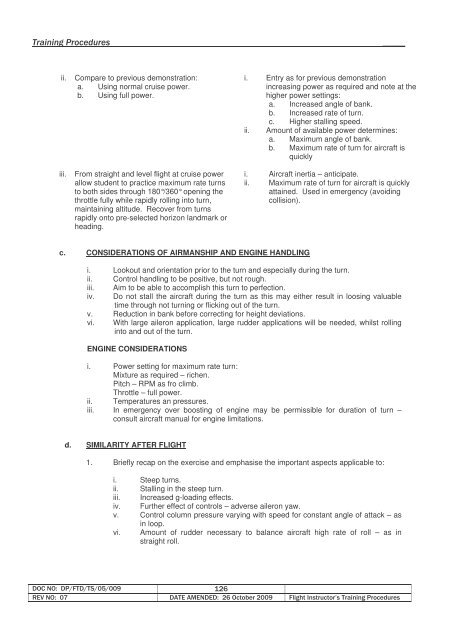Flight Instructors Training Procedures _revised AIC_x
Flight Instructors Training Procedures _revised AIC_x
Flight Instructors Training Procedures _revised AIC_x
You also want an ePaper? Increase the reach of your titles
YUMPU automatically turns print PDFs into web optimized ePapers that Google loves.
ii.<br />
iii.<br />
Compare to previous demonstration:<br />
a. Using normal cruise power.<br />
b. Using full power.<br />
From straight and level flight at cruise power<br />
allow student to practice maximum rate turns<br />
to both sides through 180°/360° opening the<br />
throttle fully while rapidly rolling into turn,<br />
maintaining altitude. Recover from turns<br />
rapidly onto pre-selected horizon landmark or<br />
heading.<br />
c. CONSIDERATIONS OF AIRMANSHIP AND ENGINE HANDLING<br />
)<br />
i. Entry as for previous demonstration<br />
increasing power as required and note at the<br />
higher power settings:<br />
a. Increased angle of bank.<br />
b. Increased rate of turn.<br />
c. Higher stalling speed.<br />
ii. Amount of available power determines:<br />
a. Maximum angle of bank.<br />
b. Maximum rate of turn for aircraft is<br />
quickly<br />
i. Aircraft inertia – anticipate.<br />
ii. Maximum rate of turn for aircraft is quickly<br />
attained. Used in emergency (avoiding<br />
collision).<br />
i. Lookout and orientation prior to the turn and especially during the turn.<br />
ii. Control handling to be positive, but not rough.<br />
iii. Aim to be able to accomplish this turn to perfection.<br />
iv. Do not stall the aircraft during the turn as this may either result in loosing valuable<br />
time through not turning or flicking out of the turn.<br />
v. Reduction in bank before correcting for height deviations.<br />
vi. With large aileron application, large rudder applications will be needed, whilst rolling<br />
into and out of the turn.<br />
ENGINE CONSIDERATIONS<br />
i. Power setting for maximum rate turn:<br />
Mixture as required – richen.<br />
Pitch – RPM as fro climb.<br />
Throttle – full power.<br />
ii. Temperatures an pressures.<br />
iii. In emergency over boosting of engine may be permissible for duration of turn –<br />
consult aircraft manual for engine limitations.<br />
d. SIMILARITY AFTER FLIGHT<br />
1. Briefly recap on the exercise and emphasise the important aspects applicable to:<br />
i. Steep turns.<br />
ii. Stalling in the steep turn.<br />
iii. Increased g-loading effects.<br />
iv. Further effect of controls – adverse aileron yaw.<br />
v. Control column pressure varying with speed for constant angle of attack – as<br />
in loop.<br />
vi. Amount of rudder necessary to balance aircraft high rate of roll – as in<br />
straight roll.<br />
!"#$ %# &"" '$ #













